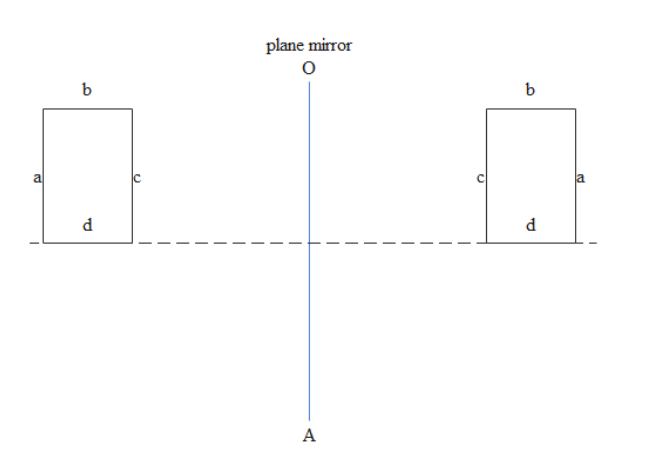
Sideways reversal of the image by plain mirror is called
A. Lateral inversion
B. Parallax
C. Optical illusion
D. None of these
Answer
490.8k+ views
Hint: In case of mirrors usually there are three types used. Plain mirror, concave mirror and convex mirror. All will serve different purposes. Properties of different mirrors are different. In case of convex mirrors they always form virtual images. While concave mirrors form both virtual and real images and we will see about plain mirrors.
Formula used:
Complete step by step answer:
In case of convex or concave mirrors the focal length of the mirror determines the type and size of the image formed. Same with the case of plane mirrors also.
Where v is the image distance while u is the object distance and f is the focal length.
But here the focal length of the plane mirror will be infinity. Mathematically the inverse of infinity will be zero. From the above formula we get
If we consider only the magnitude distance of the object from the mirror will be equal to the distance of image from the mirror and magnification of the mirror will be
Hence if magnification is positive then image formed will be erected and rule is when only one mirror is present and image formed is erected then that image must be virtual. Size of the object will be equal to the size of the image.
Hence an image formed by a plane mirror is always virtually erect and laterally inverted.

In the above image formed due to the plane mirror it is laterally inverted i.e left portion of object becomes right side portion for the mirror.
Since image distance equals the object distance, lateral magnification also will be 1 but inverted laterally.
Hence option A is the answer.
Note:
In case of plane mirrors the magnification is always one i.e size of image will be always equal to size of an object let it be longitudinal size or the lateral size. Real image can never be formed by the plane mirror that’s why the image formed by the plane mirror can’t be caught on the screen.
Formula used:
Complete step by step answer:
In case of convex or concave mirrors the focal length of the mirror determines the type and size of the image formed. Same with the case of plane mirrors also.
Where v is the image distance while u is the object distance and f is the focal length.
But here the focal length of the plane mirror will be infinity. Mathematically the inverse of infinity will be zero. From the above formula we get
If we consider only the magnitude distance of the object from the mirror will be equal to the distance of image from the mirror and magnification of the mirror will be
Hence if magnification is positive then image formed will be erected and rule is when only one mirror is present and image formed is erected then that image must be virtual. Size of the object will be equal to the size of the image.
Hence an image formed by a plane mirror is always virtually erect and laterally inverted.

In the above image formed due to the plane mirror it is laterally inverted i.e left portion of object becomes right side portion for the mirror.
Since image distance equals the object distance, lateral magnification also will be 1 but inverted laterally.
Hence option A is the answer.
Note:
In case of plane mirrors the magnification is always one i.e size of image will be always equal to size of an object let it be longitudinal size or the lateral size. Real image can never be formed by the plane mirror that’s why the image formed by the plane mirror can’t be caught on the screen.
Recently Updated Pages
Master Class 12 Business Studies: Engaging Questions & Answers for Success

Master Class 12 English: Engaging Questions & Answers for Success

Master Class 12 Social Science: Engaging Questions & Answers for Success

Master Class 12 Chemistry: Engaging Questions & Answers for Success

Class 12 Question and Answer - Your Ultimate Solutions Guide

Master Class 11 Business Studies: Engaging Questions & Answers for Success

Trending doubts
Draw a labelled sketch of the human eye class 12 physics CBSE

a Tabulate the differences in the characteristics of class 12 chemistry CBSE

Which one of the following is a true fish A Jellyfish class 12 biology CBSE

Why is the cell called the structural and functional class 12 biology CBSE

Differentiate between homogeneous and heterogeneous class 12 chemistry CBSE

Write the difference between solid liquid and gas class 12 chemistry CBSE




